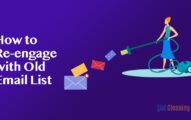
Rule #1 of email registration forms: Get to the point quickly! So, without lingering around, let’s get started improving your registration forms right now.
In this post, we’ll teach you how to make your newsletter signup form more appealing and engaging so that your website visitors realise the benefit and sign up right away.
What is an email sign up form?
Marketers utilise email registration forms (don’t hesitate in spending money for the premium ones, if they’re worth it) to gather new members for their mailing list. Use signup forms that include embedded forms, pop-up forms, and landing sites.
Every signup form should contain form fields where new email subscribers may input their information (email address, name, phone number, etc.) and grant consent to receive newsletters.
Your invitation is your email registration form. Your online business card. On a promise, your firm (or not-so-firm) handshake. So create something that will stick with you.
Why is it beneficial to improve your signup form?
A good email registration form is more than just a headline that says, “Sign up for our newsletter.” In this chapter, you’ll discover how the correct text can make or break your business.
Assume you have a pop-up signup form on your website. A pop-up will appear just before a website visitor departs, encouraging them to sign up for your newsletter.
Which one would entice you to click?
Option B is our best guess.
A headline promoting free delivery is more attractive than a generic text that simply says “Newsletter.”
A well-designed registration form with the appropriate text may boost conversion rates, develop your email list, and increase revenues. As a result, optimising your email registration form makes sense.
How to Use Email Signup Forms to Generate Leads
When discussing email registration forms, the term “leads” is frequently used.
A lead is just contact information saved from someone who expresses interest in your product or service. A lead’s goal is to nurture the relationship and convert this individual into a paying client (also called lead conversion).
Leads may be gathered in a variety of methods, both on and off the internet.
You capture leads when you add, for example, a newsletter signup form or a quotation request form to your website.
The mechanism you utilise to save contact information is your email newsletter subscription form. It’s totally up to you to strategically place the signup form so that people see it and take action.
There are several strategies to advertise your signup form:
- As a URL in your social media profile about section
- As a link in your YouTube video’s description
- In your podcast’s show notes
- In your website’s “about” section
- As a content improvement, it was woven into a blog piece.
- Mentioning it in your upcoming webinar
- Utilizing a forms app or paper and pen when offline (trade show, event, etc)
- Including a link to it in a sponsored advertisement
- Integrated on a certain landing page
Once you’ve secured a lead, it’s up to you to entice your new subscriber to become a fan of your business. After someone joins up, you may automate a lead magnet email series to build a connection.
Example of lead creation using email marketing :
- Amy clicks on a Google ad for a free blogging course.
- Amy is sent to a landing page with a short film that describes what the course includes. She then enters her name and email address to join up.
- A double opt-in email is sent to her in order for her to confirm her membership.
- She receives a welcome email once she has been verified, which gets her enthusiastic about her impending course.
- Amy receives an email a day later with all of the information she needs to get started, including her logins, course materials, and access to a private Facebook group.
- Every day for the next ten days, Anne receives an email with a new lesson.
- On day 12, after the course has concluded, Amy receives an email in which she is requested to provide feedback (directly within the email with the use of an embedded survey).
- She then receives an email promoting an advanced paid blogging course.
- Amy’s odds of upgrading to a paid course are significantly better because she is already familiar with the course’s quality and worth.
10 signup form elements to optimize
First and foremost: Begin with your WHY.
It’s obvious why you want website visitors to join up, but what do they get out of it? Why is your newsletter registration useful rather than just another unread email in their inbox?
Take some moments to consider what makes your newsletter relevant. Then incorporate that response into your registration form. Before joining up for your email, website visitors want to be convinced that it offers value.
Do you understand? Great!
Here are ten registration form components to experiment with in order to create your own blazing lead acquisition engine.
1. Signup reason
Will you just flood their inbox with newsletters promoting your items, or will your newsletters truly provide them with something of value?
Your registration reason should be as clear and appealing as possible.
The best way to achieve this depends on your audience.
We recommend keeping track of your registration form analytics and optimising the language once you’ve gathered enough data. A/B testing may be performed using a tool such as Google Analytics. When performing an A/B test, just change one element at a time to determine which element was responsible for the difference.
2. Signup form content
There are several aspects you may experiment with when it comes to the content of the signup form.
First, let’s talk about the phrasing. A slight change in the headline from “Join our newsletter” to “Sign up to get exclusive material” may have a big effect. It’s a question of performing A/B tests and then some more to see what works best for you.
Then there’s the button. Yes, even the button may have an impact on your success.
Consider the following case study: BettingExpert.com observed a 31.54 percent boost in signups after changing their button text from “Sign up +” to “Sign Up & Get the Best Daily Tips.”
Third, consider the colours and design of your signup form. To ensure that your registration form blends in seamlessly with the rest of your design, we recommend keeping it in the same style as your website colours. Having said that, you do want your signup form to stand out.
Experiment with different colours, add an image backdrop to your signup form, make the headline a bit bigger—make small changes at a time and see if the signup rate rises.
3. Signup form placement
The location of your signup form is likely to be one of the most significant elements in your signup success. You’ll want to put it somewhere where others can see it.
The following are the most frequent areas to include a registration form on your website:
- Header
- Footer (bottom of the page)
- About page
- Underneath or intertwined with a blog post
- Sidebar
- On a certain landing page
- Resources page
- As a floating bar
- Sign-up page
Don’t be afraid to integrate your signup form in a number of locations. Pop-ups are a wonderful method to get the attention of website visitors since you can’t avoid them.
Don’t get too enthusiastic while utilising signup form pop-ups. Begin with a form on one page and configure it as an exit intent pop-up, which means it will appear as the consumer is ready to leave your website. This is the least intrusive approach to deploy a pop-up.
You may configure the pop-up to appear after a few seconds if you want your email list sign-up promotion to be more apparent.
Don’t get too enthusiastic while utilising signup form pop-ups. Begin with a form on one page and configure it as an exit intent pop-up, which means it will appear as the consumer is ready to leave your website. This is the least intrusive approach to deploy a pop-up.
You may configure the pop-up to appear after a few seconds if you want your email list sign-up promotion to be more apparent.
4. Display some social evidence.
Humans are pack creatures, and we are more inclined to buy items or sign up for subscription services that other people are already using, just as we are more likely to sit down at a restaurant with a patio packed full of other diners.
Before handing their money or email address to a new business, it’s reasonable to assume that most consumers conduct some type of research to locate customer evaluations. We’re looking for social evidence.
Rather than waiting for consumers to Google your brand, provide social evidence on the registration form. You may immediately integrate customer reviews or testimonials on your landing page. Also, provide social media links alongside the forms so that visitors may visit your social media accounts and read what others are saying about your company.
5. Pre-selected subjects (tagging subscribers)
Do you provide more than one kind of newsletter? Is each newsletter devoted to a different subject? Allow subscribers to choose which ones to receive.
Customers may pre-select which newsletters they want by adding subjects to their email newsletter subscription form. After self-selecting their subjects, your new subscribers will be instantly tagged and placed in the appropriate interest group.
6. Incentives might be used to sweeten the offer.
Either they adore your brand, you’ve written incredibly persuasive copy, or… you provide an incentive. The latter is the simplest approach to get folks to sign up for your email list.
An incentive is a small virtual reward you provide in exchange for individuals providing you with their data. This can be a discount, a download, or anything else your audience would be interested in. Online stores frequently provide a discount coupon, whereas blogs frequently include a checklist, ebook, guide, challenge, or online course.
7. Responsiveness
Do you know how your pop-up appears on mobile?
Pop-ups that aren’t responsive and hence overly large for mobile displays may be quite irritating. Visitors to the website will be unable to simply close the pop-up, which will have a negative impact on their user experience.
The most secure approach to ensure your signup form has a low irritation level is to design it with email software. There are several applications that will automatically resize the form to look excellent on all devices.
8. Countdown with a pop-up
You want people to know when you’re having an event, commemorating a particular day, or introducing new items. A countdown pop-up is an excellent method to raise awareness of your event. A countdown will clock down the days, and a CTA button will prompt them to take the required action.
9. Use an integration to make your life simpler.
Extend your signup form outside the confines of your website. Instead of manually tinkering with code, utilise one of the readymade integrations that are available. The paid ones these days have Facebook, Thrive, and Upscribe connections, as well as plugins for Shopify, WordPress, and WooCommerce. After you’ve implemented the integration, it’ll be a snap to add a form to the integration website.
10. Maintain a clean and GDPR-compliant list.
So you’ve worked hard to create a stunning newsletter. Let’s make sure you’re gathering subscribers who aren’t robots and who understand and agree to get the stuff you’re providing.
Create clear and informative content for your signup form so that potential subscribers understand what they’re signing up for. That way, you could be entirely certain that the folks who sign up are genuinely interested in what you’re giving.
Furthermore, optimising your email registration form to gather clear, active permission is the best approach to maintain excellent email list hygiene. If you have European Union subscribers, your signup forms must also be GDPR compliant. But don’t worry, the most reputed ones out there do come with GDPR compliance.
Keep on visiting ListCleaningAdvice, where you get premium level tips for entirely free. We take an oath of making your email campaigns successful!


